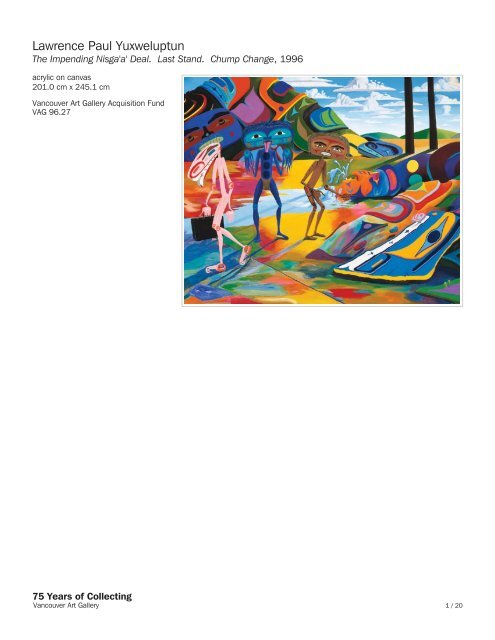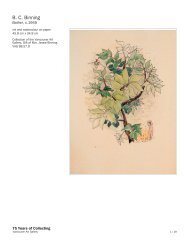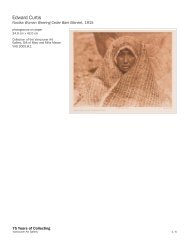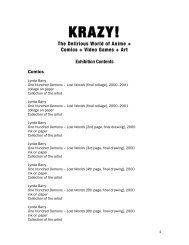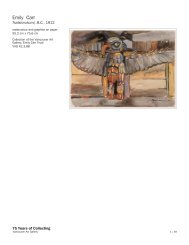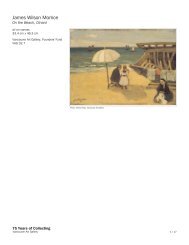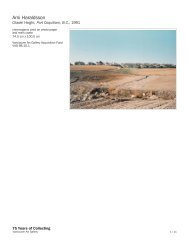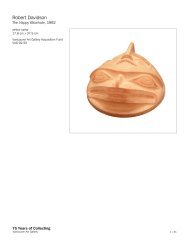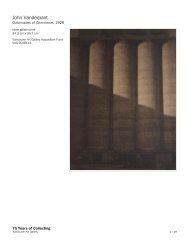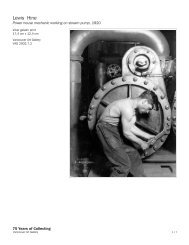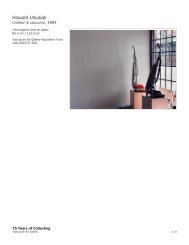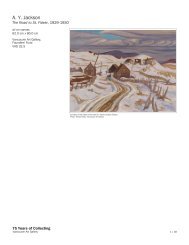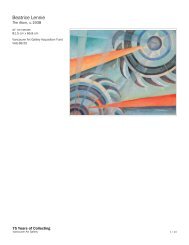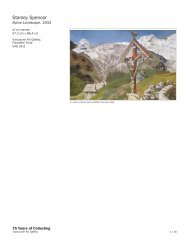Lawrence Paul Yuxweluptun - 75 Years of Collecting - Vancouver ...
Lawrence Paul Yuxweluptun - 75 Years of Collecting - Vancouver ...
Lawrence Paul Yuxweluptun - 75 Years of Collecting - Vancouver ...
You also want an ePaper? Increase the reach of your titles
YUMPU automatically turns print PDFs into web optimized ePapers that Google loves.
<strong>Lawrence</strong> <strong>Paul</strong> <strong>Yuxweluptun</strong><br />
The Impending Nisga'a' Deal. Last Stand. Chump Change, 1996<br />
acrylic on canvas<br />
201.0 cm x 245.1 cm<br />
<strong>Vancouver</strong> Art Gallery Acquisition Fund<br />
VAG 96.27<br />
<strong>75</strong> <strong>Years</strong> <strong>of</strong> <strong>Collecting</strong><br />
<strong>Vancouver</strong> Art Gallery<br />
1 / 20
<strong>Lawrence</strong> <strong>Paul</strong> <strong>Yuxweluptun</strong><br />
The Impending Nisga'a' Deal. Last Stand. Chump Change, 1996<br />
Image source:<br />
www.practicallynothing.oxyfx.com<br />
Photo by: Jim Jardine<br />
<strong>75</strong> <strong>Years</strong> <strong>of</strong> <strong>Collecting</strong><br />
<strong>Vancouver</strong> Art Gallery<br />
Artist's Biography<br />
Nationality: Canadian<br />
Born: 1957, Kamloops, B.C.<br />
<strong>Lawrence</strong> <strong>Paul</strong> <strong>Yuxweluptun</strong> was born in Kamloops, B.C. in 1957, though he<br />
spent most <strong>of</strong> his adolescence in the <strong>Vancouver</strong> area. His father is from the<br />
Cowichan Salish and his mother is from the Okanagan.<br />
He was active in various art courses in high school and after graduating, enrolled<br />
at Emily Carr College from 1978 through 1983. While at Emily Carr,<br />
<strong>Yuxweluptun</strong> was influenced by Don Jarvis, Ken Wallace, Sylvia Scott, Bruce<br />
Boyd, and Bill Featherston.<br />
Much <strong>of</strong> the content <strong>of</strong> his work is derived from contemporary Native social and<br />
political issues. His father at one time was President <strong>of</strong> the North American<br />
Indian Brotherhood and his mother was Executive Director <strong>of</strong> the Indian<br />
Homemakers Association.<br />
Most <strong>of</strong> his work has been large scale acrylic on canvas pieces with brush and/or<br />
a palette knife. He makes use <strong>of</strong> vivid colours and his work presents a positive<br />
aesthetic impression as well as expression <strong>of</strong> content that is <strong>of</strong>ten bi-cultural.<br />
In his work <strong>Yuxweluptun</strong> uses Coast Salish cosmology, Northwest Coast formal<br />
design elements, and the Western landscape tradition.<br />
Source: <strong>Vancouver</strong> Art Gallery Library Canadian Artist Files<br />
Artistic Context<br />
Nationality: Canadian<br />
First Nations Affiliation: Coast Salish<br />
Training: Emily Carr School <strong>of</strong> Art and Design<br />
Group: Northwest Coast formal design elements; 20th century; 21st century<br />
Provenance: purchased from the Artist in 1996<br />
Subject: Coast Salish cosmology; First Nations politics; landscape; cultures in<br />
conflict<br />
Other Works in the <strong>Vancouver</strong> Art Gallery Collection<br />
<strong>Lawrence</strong> <strong>Paul</strong> <strong>Yuxweluptun</strong><br />
Shaman Dancing in Sunset, 1989<br />
acrylic on canvas<br />
<strong>Vancouver</strong> Art Gallery Acquisition Fund<br />
VAG 91.58<br />
<strong>Lawrence</strong> <strong>Paul</strong> <strong>Yuxweluptun</strong><br />
Clear Cut to the Last Tree, 1993<br />
screenprint on paper<br />
<strong>Vancouver</strong> Art Gallery Acquisition Fund<br />
VAG 94.14.1<br />
2 / 20
<strong>Lawrence</strong> <strong>Paul</strong> <strong>Yuxweluptun</strong><br />
The Impending Nisga'a' Deal. Last Stand. Chump Change, 1996<br />
<strong>75</strong> <strong>Years</strong> <strong>of</strong> <strong>Collecting</strong><br />
<strong>Vancouver</strong> Art Gallery<br />
<strong>Lawrence</strong> <strong>Paul</strong> <strong>Yuxweluptun</strong><br />
Transformation <strong>of</strong> Bill Wilson, 1999<br />
hair, mirror, rawhide, and acrylic on wood<br />
Gift <strong>of</strong> the Artist<br />
VAG 96.33<br />
<strong>Lawrence</strong> <strong>Paul</strong> <strong>Yuxweluptun</strong><br />
Borderlines, 1996<br />
watercolour and ink on paper<br />
<strong>Vancouver</strong> Art Gallery Acquisition Fund<br />
VAG 96.39.3<br />
<strong>Lawrence</strong> <strong>Paul</strong> <strong>Yuxweluptun</strong><br />
An Indian Shooting the Indian Act, 1997<br />
shotgun, fabric, copy <strong>of</strong> the Indian Act, display case<br />
<strong>Vancouver</strong> Art Gallery Acqusition Fund<br />
VAG 98.18<br />
<strong>Lawrence</strong> <strong>Paul</strong> <strong>Yuxweluptun</strong><br />
The Urban Rez, 1998<br />
acrylic on canvas<br />
Gift <strong>of</strong> Maryon and Jack Adelaar<br />
VAG 2001.43.6<br />
<strong>Lawrence</strong> <strong>Paul</strong> <strong>Yuxweluptun</strong><br />
Space, Place, and Reason, 2001<br />
acrylic and oil on canvas<br />
<strong>Vancouver</strong> Art Gallery Acquisition Fund with the financial support <strong>of</strong> the Canada<br />
Council for the Arts, York Wilson Endowment<br />
VAG 2002.15<br />
<strong>Lawrence</strong> <strong>Paul</strong> <strong>Yuxweluptun</strong><br />
Mountain View Cemetary, 1996<br />
oil on canvas<br />
Gift <strong>of</strong> the Artist<br />
VAG 2005.24.1<br />
Bibliography<br />
Art BC: Masterworks from British Columbia.<br />
Publication<br />
2000<br />
[transcription <strong>of</strong> excerpt]<br />
<strong>Lawrence</strong> <strong>Paul</strong> <strong>Yuxweluptun</strong><br />
The relationship <strong>of</strong> the First Nations <strong>of</strong> British Columbia to the economically and<br />
politically dominant white society has been a vexed one for over a century.<br />
British Columbia, unlike many other parts <strong>of</strong> Canada, did not sign any treaties<br />
with the First Nations and, instead <strong>of</strong> attempting to compensate them for their<br />
land, simply took it and consigned the people to reserves.<br />
The process <strong>of</strong> treaty negotiations has been a long and, for the First Nations, a<br />
3 / 20
<strong>Lawrence</strong> <strong>Paul</strong> <strong>Yuxweluptun</strong><br />
The Impending Nisga'a' Deal. Last Stand. Chump Change, 1996<br />
<strong>75</strong> <strong>Years</strong> <strong>of</strong> <strong>Collecting</strong><br />
<strong>Vancouver</strong> Art Gallery<br />
frustrating one. The completion in the year 2000 <strong>of</strong> a treaty between the federal<br />
and provincial governments and the Nisga'a nation was, therefore, an<br />
exceptionally important historical event. This treaty was presented, particularly by<br />
the British Columbia government, as being fair and equitable to all <strong>of</strong> the<br />
province's citizens, but it was not greeted with universal approbation.<br />
A simple reading <strong>of</strong> this painting by <strong>Lawrence</strong> <strong>Paul</strong> <strong>Yuxweluptun</strong> is as a protest<br />
against the terms <strong>of</strong> this treaty: too little, too late and a sell-out <strong>of</strong> aboriginal<br />
interests. This abrasive stance, at odds with both the Nisga'a elders who had<br />
negotiated with the governments and the elected <strong>of</strong>ficials <strong>of</strong> the governments<br />
themselves, is typical <strong>of</strong> the position that <strong>Yuxweluptun</strong> has taken in much <strong>of</strong> his<br />
art. He is deeply connected to his heritage as a man <strong>of</strong> mixed Okanagan and<br />
Coast Salish ancestry but cannot separate himself from the larger, non-Native<br />
society in which he now lives. He is an urban Indian, trained at the Emily Carr<br />
College <strong>of</strong> Art and Design, and his art partakes <strong>of</strong> conflicting traditions: Native<br />
and non-Native, popular culture and the spiritual world <strong>of</strong> his ancestral past,<br />
surrealism and landscape painting in Canada. He also chooses to transgress<br />
more traditional borders <strong>of</strong> appropriation by using forms and ideas from<br />
aboriginal cultures not his own. An underlying belief in the essential spiritual<br />
quality <strong>of</strong> the earth itself and an anger at our despoiling <strong>of</strong> it animates all <strong>of</strong> his<br />
work.<br />
The immediate impact <strong>of</strong> this painting is due to the almost garish and brutal<br />
coloration. It is a landscape, or perhaps more accurately a statement about the<br />
landscape, that is far from natural. The hill formations are covered with modified<br />
Northwest Coast Native art forms—ovoids and formlines—that suggest<br />
<strong>Yuxweluptun</strong>'s study <strong>of</strong> a number <strong>of</strong> other First Nations cultures. The only trees<br />
left in the landscape are two black monoliths that do not appear to be alive but,<br />
like the denuded landscape, have been destroyed. The ground upon which the<br />
figures stand seems almost molten, as if the hills themselves had begun to melt<br />
and form an unstable sea. The white man, equipped with a briefcase, skulks <strong>of</strong>f<br />
with a self-satisfied grin on his face while the two aboriginal figures seem<br />
transfixed by shock and/or despair. Ironically, the serene sky filled with fluffy<br />
clouds suggests a harmony that is sorely lacking below.<br />
This painting has a distinctly political stance: <strong>Yuxweluptun</strong> wants viewers to feel<br />
uneasy, and he particularly aims it at a white audience to make us consider the<br />
consequences <strong>of</strong> our collective actions. The work does not present a picture <strong>of</strong><br />
optimism, for while the treaty itself has been passed, <strong>Yuxweluptun</strong> suggests that<br />
it will be some time before the ramifications <strong>of</strong> this historic event will really be<br />
understood. Sadly, he suggests disaster.<br />
4 / 20
<strong>Lawrence</strong> <strong>Paul</strong> <strong>Yuxweluptun</strong><br />
The Impending Nisga'a' Deal. Last Stand. Chump Change, 1996<br />
<strong>75</strong> <strong>Years</strong> <strong>of</strong> <strong>Collecting</strong><br />
<strong>Vancouver</strong> Art Gallery<br />
A Bad Colonial Day<br />
Publication<br />
2005<br />
[transcription <strong>of</strong> excerpt]<br />
Confronting Colonialism<br />
George Harris<br />
This exhibition <strong>of</strong> <strong>Lawrence</strong> <strong>Paul</strong> <strong>Yuxweluptun</strong>'s paintings <strong>of</strong>fers representations<br />
<strong>of</strong> First Nations life in Canada and British Columbia in particular. Like all artwork<br />
these paintings embody the perspective <strong>of</strong> an artist working within a specific<br />
socio-political and cultural context. <strong>Lawrence</strong> <strong>Paul</strong> <strong>Yuxweluptun</strong> has developed<br />
his practice in a colonialist hegemony. As an Aboriginal artist <strong>of</strong> Coast Salish<br />
ancestry, his work expounds the view <strong>of</strong> someone living within sovereign territory<br />
that has been occupied. As the title <strong>of</strong> this exhibition suggests, A Bad Colonial<br />
Day, confronts from that perspective and gives no quarter.<br />
Urban Rez (figure 1) is a powerful reflection <strong>of</strong> this point-<strong>of</strong>-view.This painting<br />
from 1998, comprised <strong>of</strong> a series <strong>of</strong> similar red shapes painted against a black<br />
background, is one <strong>of</strong> the earlier works that reflect the artist's interest in and<br />
development <strong>of</strong> "Ovoidism". a concept born <strong>of</strong> Northwest Coast art.<br />
The repeated red element, an ovoid, is a shape associated with a number <strong>of</strong> the<br />
First Nation Cultures usually grouped together as "Northwest Coast." The black<br />
and red colours the artist has chosen for this painting are also frequently<br />
associated with Northwest Coast art. Together, they are crucial elements <strong>of</strong><br />
"formline design" defined by Bill Holm'.<br />
In a catalogue for Colour Zone, Monika Kin Gagnon refers to Holm in describing<br />
this form and articulating its association with "Haida, Tsimshian and Tlingit<br />
composition", while Petra Watson describes it as an allegory that recalls "a<br />
broader cultural and marketing identity <strong>of</strong> the art and culture <strong>of</strong> the NWC." In this<br />
context, it is possible to read <strong>Yuxweluptun</strong>'s ovoids as a reflection <strong>of</strong> a kind <strong>of</strong><br />
cultural hybrid that pervades the impressions about BC First Nation Cultures in<br />
Euro-Canadian thinking. These (mis)impressions <strong>of</strong>ten displace, especially in<br />
non-native populations, more accurate characterizations <strong>of</strong> the diverse and<br />
distinct First Nation cultures in BC.<br />
However, rather than correct this impression, <strong>Yuxweluptun</strong> uses the form to<br />
establish a position <strong>of</strong> strength, reclaiming it in his own terms. In his Manifesto<br />
<strong>of</strong> Ovoidism that also appears in the Colour Zone publication, the artist asserts<br />
that his ovoids serve<br />
"as a philosophy to think about such things as land claims, Aboriginal rights, self<br />
determination and self government, social conditions and environmentalism,<br />
Native reason and Native philosophy...to express Native 'modernalities' and to<br />
intellectualise place, space and Native reason."<br />
Ovoidism, he states, is fundamentally about "colonial deconstruction and<br />
Aboriginal reconstruction."<br />
In this framework, Urban Rez takes on an interesting meaning. The term<br />
describes, with <strong>of</strong>ten bleak connotations, the community <strong>of</strong> First Nation peoples<br />
from diverse cultural origins that populate the city as a result <strong>of</strong> what has been<br />
described as an "aboriginal migration." In this reading, the ovoids in this painting<br />
represent these people and their habitation. The title implies a convergence <strong>of</strong><br />
different cultural backgrounds and their disenfranchisement and ghettoisation.<br />
5 / 20
<strong>Lawrence</strong> <strong>Paul</strong> <strong>Yuxweluptun</strong><br />
The Impending Nisga'a' Deal. Last Stand. Chump Change, 1996<br />
<strong>75</strong> <strong>Years</strong> <strong>of</strong> <strong>Collecting</strong><br />
<strong>Vancouver</strong> Art Gallery<br />
Nevertheless, these forms do not shrink from view but have instead been<br />
painted bluntly, expressing a proud and assertive sense <strong>of</strong> power. These<br />
expressions are not specifically <strong>of</strong> <strong>Yuxweluptun</strong>'s Coast Salish identity, but are an<br />
articulation <strong>of</strong> a more general Aboriginal voice, strengthened ultimately through<br />
the deconstruction <strong>of</strong> 'colonial' generalization.<br />
In Space, Place and Reason (figure 2), from 2001, a riot <strong>of</strong> multi-layered and<br />
multi-coloured ovoids populates the canvas. Unlike Urban Rez where the<br />
collection <strong>of</strong> solitary forms projected a sentry-like strength, this painting's<br />
strength derives from the number and density <strong>of</strong> ovoids from which it is<br />
comprised. At first the brightly coloured painting reads as a celebration; perhaps,<br />
as its title suggests, <strong>of</strong> the quality <strong>of</strong> "reason" (the ability to work something out),<br />
as well as <strong>of</strong> space and place. However, the title also <strong>of</strong>fers a more disquieting<br />
reading in which "reason" can be understood as "cause" In many First Nations<br />
communities issues <strong>of</strong> space and place are <strong>of</strong> primary importance as land<br />
claims are slowly being resolved. As a contemporary artist documenting what he<br />
sees, <strong>Yuxweluptun</strong> presents space and place here in abstract terms, as the<br />
arena <strong>of</strong> both negotiation and motive.<br />
The Transformation <strong>of</strong> Bill Wilson (figures 3a and 3b), engages this debate in<br />
less abstract terms. Bill Wilson is an activist for BC First Nations and has been<br />
involved with land claims and other issues affecting First Nation peoples. A<br />
stylized flattened head has been built from two panels that are hinged at the left<br />
and right edges and meet in the middle. Translating the device <strong>of</strong> an articulated<br />
transformation mask common to a number <strong>of</strong> Northwest Coast cultures,<br />
<strong>Yuxweluptun</strong>'s painting opens up to reveal the phrase "SELF GOVERNMENT<br />
NOW." As expressed in his manifesto <strong>of</strong> ovoidism this is clearly a notion for<br />
which <strong>Yuxweluptun</strong> is willing to agitate.<br />
In its closed position, the painting is strongly reminiscent <strong>of</strong> the characters found<br />
in many <strong>of</strong> <strong>Yuxweluptun</strong>'s two-dimensional work such as Impending Nisga'a Deal.<br />
Last Stand. Chump Change. (figure 4). Here three characters occupy the middle<br />
<strong>of</strong> the painting. The heads <strong>of</strong> the two characters on the right, shaped as ovoids,<br />
are shown head on and are rendered in much the same way as Bill Wilson's<br />
visage. The character on the left appears to be walking away and is represented<br />
in pr<strong>of</strong>ile carrying a briefcase: a convention in <strong>Lawrence</strong> <strong>Paul</strong> <strong>Yuxweluptun</strong>'s work<br />
which is used to represent Indian agents, bureaucrats, and other non-Native<br />
people. The central character, with tongue poking out, seems to taunt the<br />
bureaucrat's departure, while the other draws attention to the land and a pile <strong>of</strong><br />
change in front <strong>of</strong> him.<br />
This painting was produced in 1996, the same year that an Agreement-in-<br />
Principle regarding Nisga'a land claims was reached. The landscape appears to<br />
be stained and barren; towards the middle <strong>of</strong> the painting the land appears<br />
ruptured. An ovoid crumpled in the bottom right hand corner seems an apt<br />
metaphor for this exhausted and used environment. The painting's title reads as<br />
a wake-up call, suggesting that in the face <strong>of</strong> the impending deal there's time to<br />
take a last stand, while Chump Change seems to be a comment on the terms <strong>of</strong><br />
the deal. After all, the Nisga'a land claim, the first settled in BC, can be traced<br />
to the 19th century. During this time, the Nisga'a endured legislation, through a<br />
1927 amendment to the Indian Act, denying First Nations people the right to<br />
seek legal counsel in their claims against the government. Contested territory<br />
was logged, mined, fished and contaminated.<br />
The painting shows three points <strong>of</strong> view. The central character, who sends the<br />
bureaucrat on his way with a taunting raspberry, has the air <strong>of</strong> a victor, but is<br />
painted with limp and impotent hands. The subject <strong>of</strong> his gaze, with mouth open<br />
in a toothy grin, leaves the scene in a way that evokes the cliché: "laughing all<br />
the way to the bank". Notably, his feet are<br />
6 / 20
<strong>Lawrence</strong> <strong>Paul</strong> <strong>Yuxweluptun</strong><br />
The Impending Nisga'a' Deal. Last Stand. Chump Change, 1996<br />
<strong>75</strong> <strong>Years</strong> <strong>of</strong> <strong>Collecting</strong><br />
<strong>Vancouver</strong> Art Gallery<br />
painted like those <strong>of</strong> a raptor. The final figure draws attention back to the land<br />
and to the pile <strong>of</strong> pennies in front <strong>of</strong> him. In him we can imagine the<br />
admonishment <strong>of</strong> "Chump Change!" as if to remind the central figure <strong>of</strong> abuses<br />
inflicted on the land he points to—imploring him to take a stand rather than sell<br />
out for mere pennies.<br />
Clear Cut to the Last Tree (figure 5) addresses a similar predicament. A lone<br />
tree occupies this landscape along with three figures. Two are located in the<br />
foreground, one standing, the other on hands and knees, grieving or unable to<br />
walk. The third emerges from the background. Tree stumps dot the foreground<br />
while in the background looms a mountain, supported by only a few points while<br />
most <strong>of</strong> its base appears to be missing. Closer inspection reveals that the<br />
mountain is a shell, gutted and barely able to support itself. Nevertheless the<br />
figure in the background holds al<strong>of</strong>t a brown ovoid, the same colour as the<br />
mountain, and possibly part <strong>of</strong> it. It is unclear whether the figure is seeking to<br />
place the ovoid somewhere to make a repair, or whether he is removing it.<br />
Either way it speaks <strong>of</strong> environmental crisis, seemingly irreversible devastation,<br />
and the dismantling <strong>of</strong> an ecosystem, turning what used to be lush and green<br />
into a virtual desert. This is exactly where the kneeling figure seems to belong, in<br />
an environment unable to sustain life.<br />
In many <strong>of</strong> these representational paintings, elements in the landscape,<br />
particularly trees and mountains are built from forms derived <strong>of</strong> Northwest Coast<br />
art. The tree in Clear Cut, for instance employs circles, and what have been<br />
defined as "split-u" shapes to define the trunk. The foliage is comprised <strong>of</strong> other<br />
forms familiar to Northwest Coast art, but even more importantly, it is rendered<br />
as a collection <strong>of</strong> heads. Some resemble human heads that the artist has<br />
painted elsewhere, others resemble so called "salmon-trout heads" and others<br />
still are harder to characterize. The use <strong>of</strong> these forms in this manner literally<br />
marks the landscape as First Nations, imprinting it with culturally specific<br />
markings which ultimately reflect belief systems, cultural practice and history. In<br />
addition to asserting the conviction that the land represented belongs within the<br />
realm <strong>of</strong> the First Nations, these forms also reflect the concept <strong>of</strong> the culturally<br />
modified tree (CMT) identified by archaeologists and anthropologists.<br />
CMTs are trees that have been altered through human interaction. They may<br />
have scars that stem from the careful harvesting <strong>of</strong> wood products, such as<br />
bark, in such a way that does not kill the tree. They may have been carved into<br />
or have been modified in other ways. They show evidence that people have used<br />
the land on which they grow, proving habitation and use <strong>of</strong> the land that can be<br />
traced back many years. Clearly this is useful in strengthening the establishment<br />
<strong>of</strong> land title. Commercial logging, however, and clearcutting in particular, imperil<br />
this potential through the literal removal <strong>of</strong> evidence.<br />
The painting also makes a larger allusion to the biosphere as a whole, reminding<br />
us <strong>of</strong> our dependency on a healthy environment. The faces <strong>of</strong> other creatures<br />
are represented in the trees and mountains because they are inextricably linked<br />
as part <strong>of</strong> a symbiotic relationship that ultimately has global consequences.<br />
Scorched Earth, Clear-cut Logging. Shaman Coming to Fix. (figure 6), is a much<br />
more complex painting on a similar theme. In the front left hand corner, a<br />
shaman, grim faced indeed, stands beside a squatting person, as elements in<br />
the landscape behind weep and lie flaccid and utterly spent. In his left hand the<br />
shaman holds a device, its eyes and mouth wide open, seemingly in horror at<br />
the scene. In his right hand he holds a staff, up which a creature runs looking<br />
down at the scorched and toxic earth from which he is escaping. Although the<br />
shaman has been called upon to try and fix the damage, his expression seems<br />
more despairing than optimistic. It is difficult to feel hopeful and not to share a<br />
sense <strong>of</strong> anger<br />
at the transgressions visited upon this land. The shaman, in his role in this<br />
7 / 20
<strong>Lawrence</strong> <strong>Paul</strong> <strong>Yuxweluptun</strong><br />
The Impending Nisga'a' Deal. Last Stand. Chump Change, 1996<br />
<strong>75</strong> <strong>Years</strong> <strong>of</strong> <strong>Collecting</strong><br />
<strong>Vancouver</strong> Art Gallery<br />
painting as "fixer", stands as an ally <strong>of</strong> <strong>Yuxweluptun</strong>, in opposition to the colonial<br />
mentality that allowed this devastation.<br />
In a statement for the National Gallery exhibition Land Spirit Power, the artist<br />
articulated this position:<br />
"I am concerned with the colonial mentality that is directly responsible for the<br />
killing <strong>of</strong> wolves, buffalo, whales, grizzly bears, and migratory birds, to the point<br />
that some species are now extinct. It is behind the depletion <strong>of</strong> fish stocks on<br />
the West and East coasts, acid rain, nuclear waste, land fills, smog, the<br />
greenhouse effect, the emission <strong>of</strong> methane gas, mining tailings, endangered<br />
animals, pollution <strong>of</strong> freshwater reservoirs, toxic wastes <strong>of</strong> all kinds, oil spills,<br />
uranium mining, nuclear testing. The next step towards de-colonization <strong>of</strong> First<br />
Nations must be recognition by the provincial governments <strong>of</strong> our sovereign<br />
indigenous government. As sovereign caretakers <strong>of</strong> the land, our forebears were<br />
always the protectors <strong>of</strong> the biosphere."<br />
Although many <strong>of</strong> these works invite interpretations in which First Nations people<br />
are shown as trying to pick up the pieces, or as astonished and defiant victims<br />
<strong>of</strong> colonial oppression, other works hint at broader consequences. In Borderlines<br />
(figure 7), a solitary figure approaches an assertive line that divides two trees on<br />
a plain surrounded by mountains. There is little difference to be seen between<br />
one side <strong>of</strong> the line and the other. We can read this border, for instance, as an<br />
arbitrary line imposed by the definitions <strong>of</strong> land title which inexplicably divide<br />
much greater expanses <strong>of</strong> land. Alternatively, it can be seen as the division<br />
between colonized and colonialist, or the cultural and economic borders that<br />
frame different philosophies <strong>of</strong> land use. Ultimately, as the artist is compelled to<br />
remind us, we may all inevitably succumb to the legacy <strong>of</strong> colonial abuses<br />
inflicted on the land.<br />
"Good luck, oh civilization, for every hundred years I will ask you to drink the<br />
water with me, my brother and sister, and l will wait for you to take the first<br />
drink."<br />
Within this sentiment lurks a justifiable bitterness and a sense <strong>of</strong> a kind <strong>of</strong><br />
inevitable poetic justice to come.<br />
In 2 People Talking about the Kyoto Accord Global Warming (figure 8) this poetic<br />
justice seems to resurface as a wolf lurking behind a tree. In the centre<br />
foreground, figures appear to chat, spewing numbers and letters onto the<br />
ground. As this nonsense pours out <strong>of</strong> them and puddles at their feet, an<br />
enormous and threatening wolf looms close by. In the background a giant<br />
chimney belches smoke into the air as the characters continue to "talk." In the<br />
right mid-ground a figure, tongue lolling on the floor like that <strong>of</strong> a hot and<br />
exhausted dog, drags himself along the ground.<br />
The painting expresses frustration around the Kyoto Accord. It is widely<br />
understood that the consequences <strong>of</strong> not reducing greenhouse emissions, as<br />
the treaty proposes, will result in worldwide temperature increases, climate<br />
change and ecological disruptions that are anticipated to be pr<strong>of</strong>ound and far<br />
reaching. The treaty remains unsigned by a number <strong>of</strong> countries, most notably<br />
the USA, and debate around it continues, complicating and delaying its<br />
implementation while further environmental damage is wrought. The<br />
wilted character on the right is feeling the effects already. The wolf, disgusted<br />
and angry, seems ready to explode from the cover <strong>of</strong> the tree in order to take<br />
matters in its own hands and exact some form <strong>of</strong> retribution.<br />
For the viewer, presented by the artist with the consequences <strong>of</strong> talk without<br />
action, it is difficult not to empathise with the wolf, and to imagine the talkers<br />
dispatched; the pollution stopped, and the exhausted character recovered. This<br />
8 / 20
<strong>Lawrence</strong> <strong>Paul</strong> <strong>Yuxweluptun</strong><br />
The Impending Nisga'a' Deal. Last Stand. Chump Change, 1996<br />
<strong>75</strong> <strong>Years</strong> <strong>of</strong> <strong>Collecting</strong><br />
<strong>Vancouver</strong> Art Gallery<br />
is a specific debate that many Canadians are sympathetic to. The Federal<br />
Government, after all, ratified the treaty. The same sympathy is not so readily<br />
available for many <strong>of</strong> the other issues <strong>Yuxweluptun</strong> addresses, which oppose a<br />
colonial hegemony and can instead appear threatening.<br />
<strong>Lawrence</strong> <strong>Paul</strong> <strong>Yuxweluptun</strong> has spoken about being a history painter<br />
documenting what he sees and experiences in large format paintings that defy<br />
being filed away and hidden from view". The artist's point <strong>of</strong> view is a reflection<br />
<strong>of</strong> life in Canada and in BC but from an all-too-<strong>of</strong>ten marginalized perspective.<br />
As the artist does in making these paintings, characters gesture at the world<br />
around them as if to ask "Do you see this"? They confront the viewer and<br />
demand at least a moment <strong>of</strong> reflection. In this moment we can't help but ask<br />
what is it that we are going to do?<br />
George Harris curated A Bad Colonial Day. He is Curator <strong>of</strong> the Two Rivers<br />
Gallery in Prince George, British Columbia.<br />
1 Holm, Bill. Northwest Coast Indian Art: An Analysis <strong>of</strong> Form. <strong>Vancouver</strong>:<br />
Douglas and McIntyre, 1988.<br />
2 Gagnon, Monika. "Unpacking the Ovoid in <strong>Lawrence</strong> <strong>Paul</strong> <strong>Yuxweluptun</strong>'s<br />
Ovoidism." Watson, Petra, ed. Colour Zone. Winnipeg: Plug In Editions, 2003. P<br />
30.<br />
3 Watson, Petra. "Seeing One Thing Through Another: The Art <strong>of</strong> <strong>Lawrence</strong> <strong>Paul</strong><br />
<strong>Yuxweluptun</strong>." Watson, Petra, ed. Colour Zone. Winnipeg: Plug In Editions,<br />
2003. P 24.<br />
4 The perception <strong>of</strong> First Nations people in Euro-Canadian Culture is addressed<br />
in The Imaginary Indian. Contrasting American colonial history with Canada's, the<br />
author writes at one point:<br />
"Canadians did not engage with the outright extermination <strong>of</strong> their native<br />
population. However;<br />
they wholeheartedly endorsed the assimilation <strong>of</strong> the Indian, which in the long<br />
run meant the same thing, an end to an identifiable Indian people."<br />
Francis, Daniel. The Imaginary Indian: The Image <strong>of</strong> the Indian in Canadian<br />
Culture. <strong>Vancouver</strong>: Arsenal Pulp Press, 1992. Pp 59-60.<br />
5 <strong>Yuxweluptun</strong>, <strong>Lawrence</strong> <strong>Paul</strong>. "The Manifesto <strong>of</strong> Ovoidism." Watson, Petra, ed.<br />
Colour Zone. Winnipeg: Plug In Editions, 2003. Pp 4-5.<br />
6 Marvin Francis describes this as follows:<br />
"The first city experience(s), loaded with culture shock, had mostly negative<br />
impact. The in-your-face racism <strong>of</strong> the seventies, when I first began to live on my<br />
own, led to extreme difficulty in finding a place to rent, employment and<br />
acceptance in the urban culture in general."<br />
Francis, Marvin. My Urban Rez. 2004. Canadian Dimension. 7 April, 2005,<br />
http://www.canadiandimension.mb.ca/v38/v38/6mf. htm<br />
Marie Burke describes the bleak prospects many experienced after moving to<br />
the "urban rez":<br />
" 'Urban rez' brings to mind a land <strong>of</strong> concrete that is disconnected from nature's<br />
beauty and sustainability, a land that held false promises for the Aboriginal<br />
people who came to find what their white brothers said was a better life for their<br />
children."<br />
Burke, Marie. Talk to the Feather: The Price Paid for the Urban Rez. 1999.<br />
9 / 20
<strong>Lawrence</strong> <strong>Paul</strong> <strong>Yuxweluptun</strong><br />
The Impending Nisga'a' Deal. Last Stand. Chump Change, 1996<br />
<strong>75</strong> <strong>Years</strong> <strong>of</strong> <strong>Collecting</strong><br />
<strong>Vancouver</strong> Art Gallery<br />
Aboriginal Multimedia Society (Alberta Sweetgrass). 6 April, 2005<br />
http://www.ammsa.com/sweetgrass/MAY99.html#anchor46 134<strong>75</strong><br />
7 Nisga 'a Final Agreement. Agreements, Treaties and Negotiated Settlements<br />
Project. Indigenous Studies Program, The University <strong>of</strong> Melbourne. 14 April,<br />
2005 http://www.atns.net.au/biogsI A00 1 630b.htm<br />
8 Francis, Daniel. P 211.<br />
9 Holm, Bill. P 32<br />
10 Muir, Robert & Moon, Heather. Sampling Culturally Modified Tree Sites: Final<br />
Report. Victoria: Ministry <strong>of</strong> Forests, Aboriginal Affairs Branch, 2000. (Accessed<br />
online at http:// srmwww.gov.bc.ca/arch/research/Sampling_CMTs.pdf).<br />
11 Nemir<strong>of</strong>f, Diana; Houle, Robert and Townsend-Gault, Charlotte. Land, Spirit,<br />
Power. Ottawa: National Gallery <strong>of</strong> Canada, 1992. P 221.<br />
12 IBID. P226.<br />
13 IBID. P 220.<br />
Running the Course:<br />
The Paintings <strong>of</strong> <strong>Lawrence</strong> <strong>Paul</strong> <strong>Yuxweluptun</strong><br />
Annette Schroeter<br />
As a prominent and controversial Canadian artist <strong>Lawrence</strong> <strong>Paul</strong> <strong>Yuxweluptun</strong><br />
communicates the many troubled truths <strong>of</strong> contemporary life as he perceives<br />
them. His starkly vivid landscapes and abstract works explore a splintered<br />
Canadian society in which few live and understand. <strong>Yuxweluptun</strong> exists amongst<br />
the fragments <strong>of</strong> First Nations and Canadian cultures. As well as working and<br />
living in one <strong>of</strong> Canada's largest urban centers, he has immersed himself in the<br />
lives and struggles <strong>of</strong> First Nation peoples. The social, economic and political<br />
disadvantages experienced by Native peoples collectively have created<br />
overwhelming issues. It is through the work <strong>of</strong> people in unique social positions<br />
such as <strong>Yuxweluptun</strong>'s that understanding and empathy can be forged. Many <strong>of</strong><br />
those individuals in positions <strong>of</strong> power in mainstream Canadian society are<br />
coming to recognize that Native cultures have important lessons and information<br />
to share, especially the will and flexibility to remake oneself based on new<br />
ideological and material influences. It is crucial for these changes to take place<br />
to remake policies in a postcolonial context in order to create a just and ethical<br />
society where the well-being and essence <strong>of</strong> all peoples and the environment<br />
are considered. <strong>Yuxweluptun</strong>'s paintings explore ideas about the environment,<br />
spirituality, social injustice, economics and cultural sharing which are all issues<br />
relevant to those peoples living in northern British Columbia.<br />
British Columbia has a unique history compared to that <strong>of</strong> the rest <strong>of</strong> Canada<br />
with regard to the relationship between First Nation peoples and the dominant<br />
Western society. For most <strong>of</strong> the twentieth century the provincial government<br />
refused to acknowledge Aboriginal title to the land and "with few exceptions, BC<br />
bands have never signed treaties extinguishing their rights to land and selfgovernment".<br />
Finally in 1991, with the installation <strong>of</strong> a new provincial<br />
government, Aboriginal title was finally acknowledged,, and, importantly, that<br />
title extended to traditional tribal lands. Decisions and policies regarding the use<br />
and management <strong>of</strong> natural resources could no longer be indiscriminately made<br />
without the consultation <strong>of</strong> Native peoples as determined by the Supreme Court<br />
<strong>of</strong> Canada:<br />
10 / 20
<strong>Lawrence</strong> <strong>Paul</strong> <strong>Yuxweluptun</strong><br />
The Impending Nisga'a' Deal. Last Stand. Chump Change, 1996<br />
<strong>75</strong> <strong>Years</strong> <strong>of</strong> <strong>Collecting</strong><br />
<strong>Vancouver</strong> Art Gallery<br />
"...the federal and provincial governments have a legal duty to consult with First<br />
Nations on development decisions affecting the land, resources, and<br />
environment <strong>of</strong> Native people."<br />
First Nations groups, such as the Lheidli T'enneh, Chilcotin, Gitskan and Nisga'a<br />
were now able to build the foundation <strong>of</strong> self-government by negotiating the right<br />
to pass their own laws, create their own institutions and to manage and protect<br />
their own land and resources.<br />
Forestry, as the principal industry in northern British Columbia, has created a<br />
series <strong>of</strong> complicated issues affecting the environment on many different levels.<br />
During the past half century the British Columbia economy has primarily been<br />
built upon the exports <strong>of</strong> raw resources such as lumber, pulp and newsprint. The<br />
rates at which these resources have been harvested and delivered to global<br />
markets have been overwhelming and have caused alarm amongst many<br />
environmental groups and concerned citizens. <strong>Yuxweluptun</strong>'s Clear Cut to the<br />
Last Tree (figure 5) and Scorched Earth, Clear-cut Logging on Native Sovereign<br />
Land. Shaman Coming to Fix. (figure 6), express the artist's sensitivity to the<br />
issue <strong>of</strong> unlimited and irresponsible resource extraction. The landscape in Clear<br />
Cut to the Last Tree is a horrific sterile vision <strong>of</strong> what may be the not too distant<br />
future. A dark figure crawls away obviously in pain and probably dying in an<br />
environment horribly and deliberately changed to a point where it can no longer<br />
sustain life. Scorched Earth, Clear-cut Logging on Native Sovereign Land.<br />
Shaman Coming to Fix depicts the grief felt not only by First Nation peoples, but<br />
by the living spiritual entities that are an intricate part <strong>of</strong> the world. Emerging<br />
from the forest is the shaman whose face depicts sorrow and pain as he surveys<br />
the row <strong>of</strong> cut trees disappearing into the sterile and stark landscape. But can<br />
the Shaman repair the damage inflicted on the land? <strong>Yuxweluptun</strong> does not<br />
believe this is possible, especially not as long as colonialism is awake. The land<br />
is a smoldering, scorched earth undergoing a transformation which must run its<br />
course.<br />
A contentious issue between Native peoples and the provincial government and<br />
industry is the intense<br />
forest harvesting activities that have continued in areas contested by claims <strong>of</strong><br />
Aboriginal title. Within these traditional territories Native peoples implement<br />
their own systems <strong>of</strong> resource extraction, including fishing, hunting and plant<br />
and berry harvesting which were carefully managed but which are now drastically<br />
disrupted by Western logging practices. <strong>Yuxweluptun</strong> feels strongly about<br />
Aboriginal people retaining their inherent rights to hunting, fishing and gathering.<br />
Access to traditional areas must not be ecologically compromised or sold <strong>of</strong>f.<br />
In Clear Cut to the Last Tree and Scorched Earth, Clearcut Logging on Native<br />
Sovereign Land. Shaman Coming to Fix, <strong>Yuxweluptun</strong> also communicates First<br />
Nation's ideas about spirituality. The faces <strong>of</strong> spirits are visible throughout the<br />
landscape, even in the cut and torn remnants <strong>of</strong> what were living trees. Western<br />
resource harvesting techniques have put at risk sites considered sacred by First<br />
Nation peoples. Many <strong>of</strong> them hold a particular reverence for specific areas<br />
where it is believed important historical events occurred.'° In addition, the<br />
living world is viewed as a provider in an endless circle <strong>of</strong> restoration and<br />
replenishment and as a shrine for the dead. It is argued that in general many<br />
people <strong>of</strong> our contemporary world do not hold a sense <strong>of</strong> the sacred especially<br />
in reference to the land and the environment.<br />
"The 'spirit <strong>of</strong> a place' or the 'spirit <strong>of</strong> the land' is <strong>of</strong>ten spoken about lightly.<br />
Place is in the background <strong>of</strong> our daily activities, shaping them without attracting<br />
our attention.''<br />
11 / 20
<strong>Lawrence</strong> <strong>Paul</strong> <strong>Yuxweluptun</strong><br />
The Impending Nisga'a' Deal. Last Stand. Chump Change, 1996<br />
<strong>75</strong> <strong>Years</strong> <strong>of</strong> <strong>Collecting</strong><br />
<strong>Vancouver</strong> Art Gallery<br />
Evidence <strong>of</strong> this deficiency is all around us as we face a building environmental<br />
crisis due to a ravenous appetite for resources that has reached global<br />
proportions." Western societies are beginning to realize that science and<br />
technology are not going to solve the ecological problems <strong>of</strong> our era. It has<br />
become clear that mainstream destructive and alienating perceptions and<br />
beliefs held by dominant Western societies need to be recognized and radically<br />
modified in order to ensure continued human survival. This apparently<br />
insurmountable task has begun to be tackled as Western systems <strong>of</strong> knowledge<br />
are viewed critically.<br />
Understanding why and how we think the way we do must begin with the<br />
knowledge that our culture determines how we perceive the world. Western<br />
thought is linear, viewing human history as a progression <strong>of</strong> development. This<br />
perception has justified attitudes <strong>of</strong> "Eurocentrism", the belief that Europeans<br />
are superior over non-Europeans, and has created a realm <strong>of</strong> oppression and<br />
domination over First Nation peoples. With this concept deeply ingrained in<br />
mainstream society, it is generally accepted that Western scientific method<br />
alone is rational and objective, and until recently other understandings or<br />
experiences <strong>of</strong> the world have not been taken seriously. "Western science<br />
degrades Indigenous knowledge and methods, regarding them as primitive,<br />
archaic and irrelevant" Many First Nation peoples conceive <strong>of</strong> reality in a cyclical<br />
way. Time moves in a circular pattern <strong>of</strong> spring, summer, fall, winter, with the<br />
cycle beginning over again and again. The past is the present and the present is<br />
the past." Over the last half century First Nation peoples have become<br />
increasingly vocal over their rights to control the direction <strong>of</strong> their own lives and<br />
the fate <strong>of</strong> their traditional territories. In response, it became clear to many<br />
Westerners that colonial practices must come to an end as they were no longer<br />
acceptable or legitimate." An emerging consensus amongst academics and<br />
those in political and industrial power seems to have developed over the<br />
legitimacy <strong>of</strong> First Nation's knowledge systems and how they can inform and<br />
work alongside Western intellectual constructs. The Federal Government <strong>of</strong><br />
Canada has recently made the decision to give equal consideration to Traditional<br />
Environmental Knowledge (TEK) and Western science in the environmental<br />
impact assessment process.<br />
"TEK is a body <strong>of</strong> knowledge and beliefs transmitted through oral tradition and<br />
first-hand observation. It includes a system <strong>of</strong> classification, a set <strong>of</strong> empirical<br />
observations about the local environment and a system <strong>of</strong> self management that<br />
governs resource use."<br />
Many First Nation peoples are sharing their ecological and cultural knowledge<br />
with Westerners so as to assert their rights and protect their interests. An<br />
important component <strong>of</strong> the knowledge held by many First Nation groups is the<br />
idea <strong>of</strong> a more holistic paradigm <strong>of</strong> all life and their relationship with each other.<br />
At the core <strong>of</strong> this is the belief that people live on this earth in a manner that is<br />
sustainable and respectful. TEK is complex and not easily understood as it does<br />
not simply contain a set<br />
only a small amount <strong>of</strong> their traditional lands, about eight percent", and they<br />
eventually will pay taxes, as well as other concessions. <strong>Yuxweluptun</strong> refers to<br />
this deal as "chump change" implying that the Nisga'a have settled for crumbs<br />
where they could have pushed for the entire feast. The treaty process is flawed<br />
as First Nation peoples are not getting fair and just treatment. Since he feels a<br />
pr<strong>of</strong>ound connection to the land and experiences the many dimensions that<br />
exist within that connection, he is skeptical <strong>of</strong> treaty negotiations.<br />
"How do you sell a season? What is the price <strong>of</strong> air? How do you sell bird song<br />
or the privilege <strong>of</strong> that free being? How do you sell the drizzle <strong>of</strong> rain on your<br />
face or the snowflake falling on your tongue?"<br />
<strong>Yuxweluptun</strong> is critical <strong>of</strong> First Nation's leaders who work on brokering these<br />
12 / 20
<strong>Lawrence</strong> <strong>Paul</strong> <strong>Yuxweluptun</strong><br />
The Impending Nisga'a' Deal. Last Stand. Chump Change, 1996<br />
<strong>75</strong> <strong>Years</strong> <strong>of</strong> <strong>Collecting</strong><br />
<strong>Vancouver</strong> Art Gallery<br />
deals and identifies deficiencies in the areas <strong>of</strong> education and ethics.<br />
The Nisga'a have a long history <strong>of</strong> negotiations with all levels <strong>of</strong> governments as<br />
they struggled for control <strong>of</strong> their lives and lands. Chief Alvin McKay states:<br />
"We do not want to recreate a world that has vanished. We do not want to turn<br />
back the clock. Far from it. We welcome the challenge to see our culture grow<br />
and change in directions we have chosen for ourselves."<br />
The Nisga'a have worked tirelessly to escape the bonds <strong>of</strong> colonialism, and yet<br />
does this new political, economic and cultural structure truly free the Nisga'a<br />
from Canadian paternalistic society? <strong>Yuxweluptun</strong> feels that it is too little too<br />
late. First Nation's leaders are assimilated and the colonized are assuming the<br />
role <strong>of</strong> colonizer.<br />
Additional controversy surrounds the Nisga'a deal as it would appear that the<br />
treaty was negotiated at the expense <strong>of</strong> their Native neighbours. The Gitanyow<br />
argue that much <strong>of</strong> their traditional lands were indiscriminately surrendered in<br />
the treaty process. As well, a Nisga'a subgroup, the Kincolith band, objected to<br />
the non-traditional governance structure mandated by the Nisga'a deal and<br />
refers to it as centralized and potentially oppressive. <strong>Yuxweluptun</strong> believes that<br />
the treaty negotiations should stop. It is not the time, as First Nation peoples'<br />
circumstances are too weak and vulnerable. Those individuals in power are "too<br />
money hungry" and may "sell out" their people's future for short term gain.<br />
For many First Nation peoples, including the Nisga'a, the treaty process is an<br />
important and necessary process as it resolves issues surrounding land<br />
ownership and stewardship <strong>of</strong> natural resources leading hopefully towards<br />
economic prosperity. This optimistic scenario is valid not only for Native peoples<br />
but also for all British Columbians as the uncertainty <strong>of</strong> doing business in B.C. is<br />
stabilized with the signing <strong>of</strong> treaties. As well, economic growth may well be<br />
stimulated with forecasts for significant employment increases. A report<br />
compiled by KPMG estimated the development <strong>of</strong> approximately 7,000 to<br />
17,000 new jobs. In addition:<br />
"the British Columbia economy can expect about $3 worth <strong>of</strong> total financial<br />
benefit for<br />
every $1 <strong>of</strong> provincial financial cost. The net financial benefit will be between<br />
$3.9 billion<br />
and $5.3 billion over 40 years."<br />
The economics <strong>of</strong> the treaty process is a contentious issue as it is difficult for<br />
many British Columbians to see past what they perceive as a financial burden.<br />
However, Nicholas Blomley states,<br />
"...it seems self-evident that my present wellbeing as a British Columbian—as a<br />
pr<strong>of</strong>essor, as a landowner, as a recipient <strong>of</strong> social benefits <strong>of</strong> various sorts—is<br />
significantly sustained by wealth forcefully expropriated from Native peoples<br />
through generations <strong>of</strong> oppression and marginalization. No amount <strong>of</strong> legal<br />
legerdemain or rhetorical sophistry can convince me that the process by which<br />
the original inhabitants <strong>of</strong> what is now British Columbia were<br />
dispossessed—economically, politically, and culturally—was anything but unjust<br />
and immoral."<br />
<strong>Yuxweluptun</strong> believes it is now time to put words into action and pay for the<br />
land, for the resources being used.<br />
"They are renting the land. They haven't even paid for back rent on this land.<br />
Paying for education doesn't even come close to covering it. Pay the rent! It's<br />
fucking due!"<br />
13 / 20
<strong>Lawrence</strong> <strong>Paul</strong> <strong>Yuxweluptun</strong><br />
The Impending Nisga'a' Deal. Last Stand. Chump Change, 1996<br />
<strong>75</strong> <strong>Years</strong> <strong>of</strong> <strong>Collecting</strong><br />
<strong>Vancouver</strong> Art Gallery<br />
The art <strong>of</strong> <strong>Lawrence</strong> <strong>Paul</strong> <strong>Yuxweluptun</strong> is critical <strong>of</strong> the colonial construct and<br />
within this context explores environmental, spiritual, social and economic issues<br />
which affect our lives. The world and cultures we live in are rapidly changing as<br />
we attempt to reconcile similarities and differences. <strong>Yuxweluptun</strong> communicates<br />
a sense <strong>of</strong> urgency as he aggressively confronts issues around forestry,<br />
Aboriginal rights and the treaty process. Although human lives and their<br />
constructs will "run their course" the small or large influences each <strong>of</strong> us can<br />
exert will cause changes. Perhaps eventually a society will emerge which allows<br />
for humans to live in harmony with each other and with the environment.<br />
Annette Schroeter is an MA candidate in the First Nations Studies program at<br />
the University <strong>of</strong> Northern British Columbia, Prince George, BC. She has lived<br />
and worked in Prince George for most <strong>of</strong> her life and is <strong>of</strong> Ojibway and German<br />
ancestry.<br />
Figure 4<br />
The Impending NIsga'a Deal, Last Stand. Chump Change., 1996,<br />
acrylic on canvas. <strong>Vancouver</strong> Art Gallery Acquisition Fund,<br />
VAG 96.27. Photo: Trevor Mills<br />
Further Reading<br />
Huhtamo, Erkki. "Breaking the Spell <strong>of</strong> White Man's Technology," <strong>Lawrence</strong><br />
<strong>Paul</strong> <strong>Yuxweluptun</strong>: Inherent Rights, Vision Rights. Banff: The Banff Centre,<br />
1991.<br />
Laurence, Robin. "Man <strong>of</strong> Masks," Canadian Art. 12 (Spring 1995): 50-55.<br />
<strong>Lawrence</strong> <strong>Paul</strong> <strong>Yuxweluptun</strong>. <strong>Vancouver</strong>: Morris and Helen Belkin Art Gallery,<br />
1995.<br />
Watson, Petra. Colour Zone. Winnipeg: Plug in Editions, 2003.<br />
<strong>Yuxweluptun</strong>, <strong>Lawrence</strong> <strong>Paul</strong>. "<strong>Lawrence</strong> <strong>Paul</strong> <strong>Yuxweluptun</strong>," Land, Spirit, Power:<br />
First Nations at the National Gallery <strong>of</strong> Canada. Ottawa: National Gallery <strong>of</strong><br />
Canada, 1992.<br />
Exhibition History<br />
Exhibitions at the <strong>Vancouver</strong> Art Gallery<br />
<strong>Lawrence</strong> <strong>Paul</strong> <strong>Yuxweluptun</strong> and Emily Carr. October 26, 1996 - January 5,<br />
1997.<br />
Change or Die. September 26, 1998 - November 15, 1998.<br />
Recollect. October 16, 1999 - January 23, 2000.<br />
Colouring the West: A Century <strong>of</strong> B.C. Painting. July 1, 2000 - May 1, 2001.<br />
The Shadow <strong>of</strong> Production: Works from the Collection. October 30, 2004 -<br />
January 16, 2005.<br />
14 / 20
<strong>Lawrence</strong> <strong>Paul</strong> <strong>Yuxweluptun</strong><br />
The Impending Nisga'a' Deal. Last Stand. Chump Change, 1996<br />
<strong>75</strong> <strong>Years</strong> <strong>of</strong> <strong>Collecting</strong><br />
<strong>Vancouver</strong> Art Gallery<br />
<strong>75</strong> <strong>Years</strong> <strong>of</strong> <strong>Collecting</strong>: First Nations: Myths and Realities. May 6, 2006 -<br />
August 27, 2006.<br />
Selected Exhibitions outside <strong>of</strong> the <strong>Vancouver</strong> Art Gallery<br />
Two Rivers Gallery, Prince George. A Bad Colonial Day. May 12, 2005 - July 11,<br />
2005.<br />
Archival History<br />
Acquisitions Justification<br />
Acquisition Record<br />
[transcription]<br />
<strong>Lawrence</strong> <strong>Paul</strong> <strong>Yuxweluptun</strong><br />
b. 1957, Kamloops, B.C.<br />
Chump Change, The Impending Nisgaa Land Deal, New Borders, The Last Stand<br />
1996<br />
acrylic on canvas<br />
6' x 7' (approx.)<br />
Vendor: the artist<br />
<strong>Lawrence</strong> <strong>Paul</strong> <strong>Yuxweluptun</strong> was born in Kamloops in 1957 <strong>of</strong> Okanagan and<br />
Coast Salish descent. <strong>Yuxweluptun</strong> grew up in <strong>Vancouver</strong> and he counts himself<br />
among the over 40,000 urban Indians living in the lower mainland. Coast Salish<br />
is his cultural affiliation and he began dancing the Sxwayxwey mask at age<br />
fourteen, a right he inherited from his father, Ben <strong>Paul</strong>. At seventeen, he was<br />
initiated as a Black Face dancer. <strong>Yuxweluptun</strong>'s work is overtly political, dealing<br />
with such critical issues as land claims, the environment, and racism. This focus<br />
is inspired by the extensive activities <strong>of</strong> his parents (<strong>Yuxweluptun</strong>'s mother was<br />
involved with the Indian Home-makers Association and his father headed the<br />
Union <strong>of</strong> B.C. chiefs, both parents were active in the North American Indian<br />
Brotherhood). "As a boy <strong>Yuxweluptun</strong> travelled with his parents all over the<br />
province to meetings; their hope was that he would become a politician. Now<br />
his father sees that he is concerned with the same politics as himself, if in<br />
different ways." 1<br />
<strong>Yuxweluptun</strong> completed a B.F.A. (with Honours) at the Emily Carr College <strong>of</strong> Art<br />
and Design in 1983. He has exhibited regularly across Canada since 1984 and<br />
was included in Indigena: Contemporary First Nations Perspectives (Museum <strong>of</strong><br />
Civilization, 1992) and Land, Spirit, Power: First Nations at the National Gallery<br />
<strong>of</strong> Canada (1992). A comprehensive retrospective <strong>Lawrence</strong> <strong>Paul</strong> <strong>Yuxweluptun</strong>:<br />
Born to Live and Die on Your Colonialist Reservations marked the opening <strong>of</strong> the<br />
new Morris and Helen Belkin Art Gallery at the University <strong>of</strong> British Columbia<br />
(1995). <strong>Yuxweluptun</strong>'s subject and signature style have remained consistent to<br />
date. Typical <strong>of</strong> the painter's work is the combination <strong>of</strong> a broad range <strong>of</strong> styles<br />
drawn from both First Nations and Western traditions. <strong>Yuxweluptun</strong> populates his<br />
Daliesque landscapes, dark interiors, and urban environments with characters<br />
constructed <strong>of</strong> a mix <strong>of</strong> "realism" and traditional First Nations motifs and graphic<br />
styles (this also true <strong>of</strong> his treatment <strong>of</strong> the landscape with clearly defined<br />
geographic forms "blanketed" by "masks"). The resulting works are <strong>of</strong>ten garish,<br />
15 / 20
<strong>Lawrence</strong> <strong>Paul</strong> <strong>Yuxweluptun</strong><br />
The Impending Nisga'a' Deal. Last Stand. Chump Change, 1996<br />
<strong>75</strong> <strong>Years</strong> <strong>of</strong> <strong>Collecting</strong><br />
<strong>Vancouver</strong> Art Gallery<br />
cartoon-like, and embody <strong>Yuxweluptun</strong>'s cutting, black sense <strong>of</strong> humour. His<br />
works can be generally divided into three<br />
1 Charlotte Townsend-Gault, The Salvation Art <strong>of</strong> <strong>Yuxweluptun</strong>, published in<br />
<strong>Lawrence</strong> <strong>Paul</strong> <strong>Yuxweluptun</strong> Born to Live and Die on Your Colonial Reservations .<br />
Morris and Helen Belkin Art Gallery, University <strong>of</strong> British Columbia, June 20 -<br />
September 16, 1996, page 8.<br />
separate (but by no means distinct) areas, Native rights (to land and culture),<br />
the state <strong>of</strong> the environment, and religious painting.<br />
Red Man Watching White Man Trying to Fix Hole in Sky (1990), currently on<br />
display at the Gallery, is clearly an environmental work. It depicts a tiny white<br />
"scientist", under observation <strong>of</strong> the giant "Red Man", attempting to patch the<br />
hole in the ozone layer. The work clearly articulates <strong>Yuxweluptun</strong>'s opinion <strong>of</strong><br />
who is responsible for the current state <strong>of</strong> the environment. A work such as<br />
Night in a Salish Longhouse, also currently at the Gallery, can be considered<br />
one <strong>of</strong> <strong>Yuxweluptun</strong>'s religious works. The work is based on a vision encountered<br />
by the artist during a religious ceremony. While the environmental and religious<br />
works are significant, the paintings which deal with Native rights are the most<br />
compelling because it is in these works that the complexity <strong>of</strong> <strong>Yuxweluptun</strong>'s<br />
understanding <strong>of</strong> contemporary issues facing First Nations peoples is most<br />
clearly articulated and where his questioning <strong>of</strong> the beliefs and actions <strong>of</strong> First<br />
Nations communities is most evident. Chump Change, presented here for<br />
acquisition, can be considered a major work within this important aspect <strong>of</strong><br />
<strong>Yuxweluptun</strong>'s production. It is his boldest work to date dealing with the subject<br />
<strong>of</strong> land claims. Further, as the formal negotiation <strong>of</strong> the Nisgaa land claim was<br />
initiated in this building when it functioned as the Provincial Court House, the<br />
artist believes the painting has an important relationship with this place and<br />
"belongs" here.<br />
In such early pieces as Haida Hotdog (1984) and Alcoholics on the Reservation<br />
(1988), <strong>Yuxweluptun</strong> engages problematic issues rarely incorporated into<br />
"traditional" First Nations work. Haida Hotdog, which depicts a traditional Haida<br />
motif adorning a wiener, addresses the blending <strong>of</strong> cultures and questions the<br />
idea <strong>of</strong> a pure traditional culture within First Nations communities. Alcoholics on<br />
the Reservation confronts in a very direct, visceral way, the existence <strong>of</strong> alcohol<br />
abuse and violence on the reserve, an aspect <strong>of</strong> First Nations' culture never<br />
depicted in the "traditional" work mass marketed to tourists and <strong>of</strong>ficially<br />
supported by government. In Chump Change, <strong>Yuxweluptun</strong> casts a sharp, critical<br />
eye on the recent Nisgaa land claim settlement and his view is damning <strong>of</strong> both<br />
the Provincial and Federal Governments as well as the Nisgaa representatives<br />
who have settled, as the title clearly identifies, for "chump change." As with the<br />
two earlier works sited, <strong>Yuxweluptun</strong> does not shy away from critiquing aspects<br />
<strong>of</strong> First Nations communities.<br />
In this garishly painted scene, the "chump change" trickles through the fingers <strong>of</strong><br />
the Nisgaa figure who stares pathetically out at the viewer. To the left, a white<br />
negotiator strides out <strong>of</strong> the scene, the agreement in his briefcase. Such<br />
negotiators have emerged as a regular presence in <strong>Yuxweluptun</strong>'s work. The<br />
white figure has crossed over the "new border" line which now defines the land<br />
claim, the two Nisgaa figures remain within the border and a significant, subtle<br />
touch on the artist's part is the inclusion <strong>of</strong> a bear's footprint which (as the artist<br />
states) will not cross the line. To the right, looming over the scene is the "last<br />
stand" two poles reaching out <strong>of</strong> the picture casting long shadows. The work<br />
brings together the breadth <strong>of</strong> <strong>Yuxweluptun</strong>'s interests. The work is obviously<br />
about land claims but it is also about much more. It addresses an exploitive<br />
16 / 20
<strong>Lawrence</strong> <strong>Paul</strong> <strong>Yuxweluptun</strong><br />
The Impending Nisga'a' Deal. Last Stand. Chump Change, 1996<br />
<strong>75</strong> <strong>Years</strong> <strong>of</strong> <strong>Collecting</strong><br />
<strong>Vancouver</strong> Art Gallery<br />
relationship between cultures in conflict, it deals with clearcutting and the<br />
obliteration <strong>of</strong> the landscape, and it openly engages contemporary political<br />
debates within First Nations communities.<br />
Chump Change, The Impending Nisgaa Land Deal, New Borders, The Last Stand<br />
would be a significant acquisition as it would be the first major work by<br />
<strong>Yuxweluptun</strong> to enter the collection. The work reflects the three recently<br />
established areas <strong>of</strong> collection strategy—a contemporary view <strong>of</strong> the British<br />
Columbia landscape, the work also addresses issues <strong>of</strong> identity while adopting<br />
and critiquing modernist models <strong>of</strong> painting. As with all <strong>of</strong> <strong>Yuxweluptun</strong>'s works,<br />
the painting aggressively plunders a wide range <strong>of</strong> cultural sources (a<br />
humourous reversal <strong>of</strong> the appropriation <strong>of</strong> indigenous cultures by many modern<br />
"masters"), clearly undermining the position <strong>of</strong> First Nations "traditionalists" and<br />
modern anthropological theories <strong>of</strong> pure, distinct cultures. As with the works by<br />
Patricia Deadman also being presented, this acquisition would add to the<br />
Gallery's holdings <strong>of</strong> work by contemporary First Nations artists.<br />
Recommendation: Purchase<br />
Andrew Hunter<br />
Associate Curator<br />
Note to File<br />
Miscellaneous History<br />
1996<br />
[transcription]<br />
<strong>Lawrence</strong> <strong>Paul</strong> <strong>Yuxweluptun</strong><br />
The Impending Nisga 'a' Deal. Last Stand. Chump Change, 1996<br />
acrylic on canvas<br />
<strong>Vancouver</strong> Art Gallery Acquisition Fund<br />
VAG 96.27<br />
The immediate impact <strong>of</strong> this work is in the intense colour. The painting is a<br />
statement about the landscape. Two black monoliths, the only trees left in the<br />
landscape, do not suggest life and growth, but destruction. The ground seems<br />
[sic] almost molten, as if the hills themselves had begun to melt and form an<br />
unstable sea. A white man, equipped with a briefcase skulks <strong>of</strong>f with a self<br />
satisfied grin on his face while the two aboriginal figures seems transfixed by<br />
shock and despair. Above, a serene sky filled with fluffy clouds suggests a<br />
harmony sorely lacking below. The work is distinctly political — <strong>Lawrence</strong> <strong>Paul</strong><br />
<strong>Yuxweluptun</strong> wants us to feel uneasy.<br />
Unlike many other parts <strong>of</strong> Canada, British Columbia did not establish early<br />
treaties between First Nations people and the provincial government. Land was<br />
simply taken, and First Nations men and women consigned to reservations. The<br />
process <strong>of</strong> treaty negotiations, which was greatly accelerated after a series <strong>of</strong><br />
court rulings that recognized aboriginal title, has been a long and, for the<br />
aboriginal peoples, a frustrating one. The impending treaty between the federal<br />
and provincial governments and the Nisga'a' peoples was therefore a singular<br />
historical event. This treaty, now accepted by the province and awaiting final<br />
ratification, was presented, particularly by the provincial government, as fair and<br />
equitable to all <strong>of</strong> British Columbia's citizens, but it has not been greeted with<br />
universal approval in either aboriginal or nonaboriginal communities. A simple<br />
reading <strong>of</strong> this work by <strong>Lawrence</strong> <strong>Paul</strong> <strong>Yuxweluptun</strong> is as a protest against the<br />
17 / 20
<strong>Lawrence</strong> <strong>Paul</strong> <strong>Yuxweluptun</strong><br />
The Impending Nisga'a' Deal. Last Stand. Chump Change, 1996<br />
<strong>75</strong> <strong>Years</strong> <strong>of</strong> <strong>Collecting</strong><br />
<strong>Vancouver</strong> Art Gallery<br />
terms <strong>of</strong> the treaty — too little, too late and a sell-out <strong>of</strong> aboriginal interests.<br />
This harsh stance, at odds with both the elders <strong>of</strong> the Nisga'a' tribes and the<br />
elected <strong>of</strong>ficials <strong>of</strong> the governments, is typical <strong>of</strong> the position that <strong>Yuxweluptun</strong><br />
has taken in much <strong>of</strong> his art. Though connected to his heritage as a man <strong>of</strong><br />
mixed Okanagan and Coast Salish ancestry he cannot separate himself from the<br />
society in which he now lives. His art reflects native and non-native traditions,<br />
popular culture, the spiritual world <strong>of</strong> his ancestral past, surrealism and the<br />
traditions <strong>of</strong> landscape painting in Canada. He willingly crosses many borders,<br />
using forms and ideas from aboriginal cultures not his own.<br />
There is an underlying belief in the essential spiritual quality <strong>of</strong> the earth itself<br />
and an anger at the despoiling <strong>of</strong> it that animates all <strong>of</strong> <strong>Yuxweluptun</strong>'s work.<br />
While the treaty itself has been passed, it will be sometime before the<br />
consequences <strong>of</strong> this historic event will really be manifest. Sadly, the artist<br />
suggests disaster.<br />
Condition Report for Acquisitions<br />
Conservation<br />
1996-09-21<br />
[transcription]<br />
VANCOUVER ART GALLERY<br />
CONDITION REPORT FOR ACQUISITIONS<br />
ARTIST: YUXWELUPTUN, LAWRENCE PAUL<br />
T.L. NO.: 96.212<br />
TITLE: THE IMPENDING NISGA DEAL, CHUMP CHANGE, THE LAST STAND, NEW<br />
BORDER LINES<br />
MEDIUM: ACRYLIC ON CANVAS<br />
DIMENSIONS: SIGNED IN BRC IN grn PAINT "YUXWELUPTUN 96"<br />
CONDITION:<br />
VERSO NOT EXAMINED<br />
AUXILIARY SUPPORT: STRETCHER? WOOD<br />
SUPPORT CANVAS, COTTON DUCK, ACRYLIC GESSO WHITE, ARTIST APPLIED<br />
OVERALL SLIGHTLY FLOPPY<br />
DESIGN LAYER: ACRYLIC, VERY LOW IMPASTO APPEARS SOUND OVERALL,<br />
GOOD ADHESION DESIGN DOES NOT EXTEND TO TACKING MARGINS SOME<br />
POINT AT SIDE EDGES, CONCERN IN HANDLING<br />
SURFACE: NO SURFACE COATING, UNEVEN MATT/SLIGHT GLOSS<br />
NO FRAME, OVERALL GOOD CONDITION<br />
REQUIRED CONSERVATION: BACKING BOARD REQUIRED<br />
— work slightly dirty along side edges, not painted<br />
SIGNED: Beth Wolchock<br />
DATE: NOV. 21. 96/SPR EX. 'LONG TIME' MAY 15.01 BW<br />
18 / 20
<strong>Lawrence</strong> <strong>Paul</strong> <strong>Yuxweluptun</strong><br />
The Impending Nisga'a' Deal. Last Stand. Chump Change, 1996<br />
<strong>75</strong> <strong>Years</strong> <strong>of</strong> <strong>Collecting</strong><br />
<strong>Vancouver</strong> Art Gallery<br />
Minutes <strong>of</strong> the Board Meeting<br />
Acquisition Record<br />
1996-09-27<br />
[transcription <strong>of</strong> excerpt]<br />
Works Recommended for Acquisition<br />
Submission<br />
4. Chump Change, The Impending Nisgaa Land Deal, New Borders, The Last<br />
Stand, 1996<br />
acrylic on canvas 6' x 7' (approx.)<br />
Artist: <strong>Lawrence</strong> <strong>Paul</strong> <strong>Yuxweluptun</strong><br />
Vendor: The Artist<br />
<strong>Yuxweluptun</strong>'s overtly political work combines a broad range <strong>of</strong> styles drawn from<br />
First Nations and Western traditions. The recommended work, his boldest to<br />
date, brings together the breadth <strong>of</strong> the artist's interests. It deals with land<br />
claims and contemporary political debates within First Nations communities, and<br />
addresses an exploitive relationship between cultures in conflict, clearcutting<br />
and the obliteration <strong>of</strong> the landscape. This work reflects the three recently<br />
established collection strategy areas: a contemporary view <strong>of</strong> the BC landscape,<br />
identity, and a critique <strong>of</strong> modernist painting. It would be the first major work in<br />
the collection by this artist and augment holdings <strong>of</strong> contemporary First Nations<br />
artists.<br />
no consistent w/ artist's letter [in pencil under title <strong>of</strong> work]<br />
Curatorial Comments: Recommend Purchase<br />
Committee Disposition: Approved Unanimously<br />
Board Approval [NOV 27 1996 stamped in ink]<br />
Outgoing Condition Report<br />
Conservation<br />
2005-03-03<br />
[transcription]<br />
<strong>Vancouver</strong><br />
Artgallery<br />
OUTGOING CONDITION REPORT<br />
ARTIST : <strong>Lawrence</strong> <strong>Paul</strong> <strong>Yuxweluptun</strong><br />
ACC. NO.:VAG 96.27<br />
TITLE : The Impending Nisga'a Deal. Last Stand. Chump Change.<br />
DATE : 1996<br />
MEDIUM: Acrylic on Canvas<br />
DIMENSIONS: (H) 201.0 x (W) 245.1 x (D) 5.1 cm<br />
19 / 20
<strong>Lawrence</strong> <strong>Paul</strong> <strong>Yuxweluptun</strong><br />
The Impending Nisga'a' Deal. Last Stand. Chump Change, 1996<br />
<strong>75</strong> <strong>Years</strong> <strong>of</strong> <strong>Collecting</strong><br />
<strong>Vancouver</strong> Art Gallery<br />
BORROWING INSTITUTIONS: May 12, 2005 - TBC Two Rivers Gallery, Prince<br />
George, B.C.<br />
Description: Brightly-coloured, highly-stylized, acrylic painting on canvas. 3<br />
figures in foreground, one walking with briefcase. Trees and mountains in background.<br />
Auxiliary Support: Wood strainer with 3 vertical cross braces and one horizontal.<br />
Fixed plywood joins and corners. Protective Corex backing board. Overall sound.<br />
Support: Medium weight canvas. Overall sound.<br />
Paint Layers: Ground layer apparent and in sound condition. Paint layer is<br />
acrylic applied with texture. Overall sound.<br />
General: Edges <strong>of</strong> canvas are painted with gesso only, and are susceptible to<br />
marking by handling. Handle with gloves and use straps for lifting and carrying.<br />
Report by: Emilie O'Brien, Conservation<br />
March 3, 2005<br />
Signed: [Monica Smith in ink]<br />
Monica Smith, Conservator<br />
Terms and Conditions<br />
The images, texts, documentation, illustrations, designs, icons and all other<br />
content are protected by Canadian and international copyright laws. The content<br />
may be covered by other restrictions as well, including copyright and other<br />
proprietary rights held by third parties. The <strong>Vancouver</strong> Art Gallery retains all<br />
rights, including copyright, in data, images, text and any other information. The<br />
Gallery expressly forbids the copying <strong>of</strong> any protected content, except for<br />
purposes <strong>of</strong> fair dealing, as defined by Canadian copyright law.<br />
20 / 20


